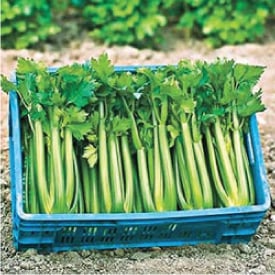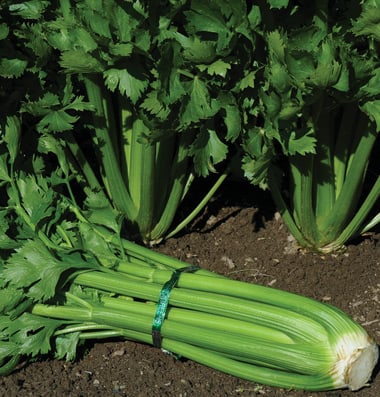
Learning Download: How to Grow Celery
From Seed to Harvest: A beginner’s guide to growing celery.
Celery is a low-calorie, high-nutrient vegetable used for its seeds, stalks and leaves. The vegetable is most often used as a garnish or a healthy snack, and it’s popular amongst grocery shoppers for its cheap cost. Celery tastes better grown from the garden, but to grow celery requires patience and skill. Celery has a long growing season, requires lots of water and has tricky-to-plant seeds.
To plant:
Celery seeds are very small and difficult to plant. To aid in planting, mix the seeds with a little bit of sand and then sprinkle the mixture over soil. Cover the seeds lightly with soil. Celery should be started indoors eight to 10 weeks before the last frost date, and it can be transplanted to the garden when temperatures are consistently topping 50 degrees. Space celery 1 foot apart in rows set 2 or 2.5 feet apart.
To grow:
Make sure celery is planted in the lowest area of the garden, as it requires lots of water. Add compost and mulch around the plants to help retain moisture. Sometimes, celery stalks will split if they do not receive enough moisture.
Some gardeners prefer to blanch their celery, which makes the stalks more tender. However, blanching reduces the vitamins in the plant as it turns the plant from green to white. To blanch, mound soil around the base of the plant each week.
To harvest
Celery can take up to 140 days before it is ready to harvest. Begin t harvest the celery when the lower stalks are 6 inches long, but the stalks are still close together. Upper stalks should reach at least 18 inches before they are ready to be picked, with a diameter of 3 inches. To harvest the celery, cut the stalks below where they join together. Gardeners can also harvest the celery leaves.
What celery craves:
Celery likes six hours of sun a day, but plant it in a place where it will be shaded during the hottest part of the day. Celery requires regular fertilization and plenty of water. Keep the soil evenly moist. Celery does best in soil with a pH between 6.0 and 7.0.
Where to buy celery seeds:
You can find different varieties of celery seeds at Urban Farmer.
Learning Download: Common pests and diseases: Celery
Common pests and diseases: Celery
When growing vegetables, it is always exciting to care for the plant throughout its growing phase and then harvest it for delicious recipes later on, but one thing to watch out for is pests and diseases. Different plants are susceptible to different types of pests and diseases, and it is important to make yourself aware so you can keep a watchful eye and also take any preventative methods to keep your plants safe throughout their lifespan.
Celery can fall victim to several different pests and diseases.
Pests:
There are a few different kinds of pests which can affect celery plants. These include aphids, armyworms and nematodes.
Nematodes can create galls on roots, yellowing plants which will then wilt in hot weather and a reduction in plant vigor. These pests prefer sandy soils and damage is more typical in fields or gardens with sandy soils. To manage these pests, plant resistant varieties, check the roots of the plants in the middle of the season and solarize the soil to reduce the nematode population.
Armyworms will feed on the leaves and create skeletonized leaves, shallow wounds on the celery and can lay eggs on the leaves. To manage this infestation, apply Bacillus thuringiensis.
Aphids can cause the leaves to yellow and become distorted, create necrotic spots on the leaves and stunt the shoots. To manage an aphid issue, use reflective mulch which will deter the aphids from feeding in your celery. If the infestation is high, use insecticides. Neem or canola oil also can help control the issue.
Diseases:
in addition to pests, celery plants can be affected by several types of disease such as bacterial blight, soft rot, celery mosaic, damping-off and more.
Bacterial blight is a problem in which water-soaked spots on the leaves become necrotic. It is caused by bacteria. Use copper sprays to control the disease, or plant celery varieties that are less susceptible to the disease.
Soft rot is also caused by bacteria, and to prevent this, celery should be planted in soil that is well-draining. Allow the celery plants to dry completely before you water them again to avoid wounding plants during harvest because this bacteria can enter the plants through its wounds.
Celery mosaic is a viral disease that creates mottling in leaves between the veins which then causes the leaves to become twisted, curled or crinkled. Young plants may become stunted. To manage this virus, implement a celery-free period for 1 to 3 months and also control umbelliferous weeds.
Damping-off causes soft and rotting seeds which then fall to germinate. It leads to the rapid death of seedlings before they even sprout from the soil. To manage this, avoid planting celery in soil that doesn’t drain well. Plant the celery in raised beds and use high quality seeds.


